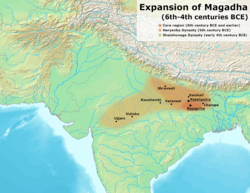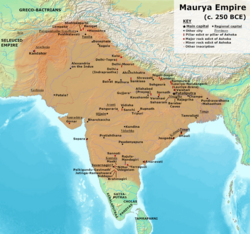Magadhan Empire | |||||||||||||
|---|---|---|---|---|---|---|---|---|---|---|---|---|---|
| 544 BCE – 415 AD | |||||||||||||
 Expansion of the Magadhan Empire between 6th and 4th century AD | |||||||||||||
The Magadha Empire under various dynasties | |||||||||||||
| Capital | Rajagriha (Girivraj) Later, Pataliputra (modern-day Patna) | ||||||||||||
| Common languages | Sanskrit[1] Magadhi Prakrit Ardhamagadhi Prakrit | ||||||||||||
| Religion | Brahmanism (later Hinduism) Buddhism Jainism | ||||||||||||
| Demonym(s) | Māgadhī | ||||||||||||
| Government | Absolute monarchy[a] | ||||||||||||
| Notable emperors | |||||||||||||
• c. 544 – c. 492 BCE | Bimbisara | ||||||||||||
• c. 492 – c. 460 BCE | Ajatashatru | ||||||||||||
• c. 413 – c. 395 BCE | Shishunaga | ||||||||||||
• c. 345 – c. 329 BCE | Mahapadma Nanda | ||||||||||||
• c. 329 – c. 321 BCE | Dhana Nanda | ||||||||||||
• c. 321 – c. 297 BCE | Chandragupta Maurya | ||||||||||||
• c. 268 – c. 232 BCE | Ashoka | ||||||||||||
• c. 185 – c. 149 BCE | Pushyamitra Shunga | ||||||||||||
• c. 319 – c. 335 CE | Chandragupta I | ||||||||||||
• c. 335 – c. 375 CE | Samudragupta | ||||||||||||
• c. 375 – c. 415 CE | Chandragupta II | ||||||||||||
| Currency | Panas | ||||||||||||
| |||||||||||||
| Today part of | |||||||||||||
The Magadhan Empire was an ancient Indian empire that succeeded the Magadha Mahajanapada. It was established by Bimbisara[2] in 544 BC. It was ruled by the Haryankas (544–413 BCE), the Shaishunagas (413–345 BCE), the Nandas (345–322 BCE), the Mauryas (322–184 BCE), the Śungas (184–73 BCE), the Kanvas (73–28 BCE) and the Guptas (320–550 CE).[3]
Under the Mauryas, Magadha became a pan-Indian empire, covering large swaths of the Indian subcontinent and Afghanistan. The Kanva dynasty lost much of its territory after being defeated by the Satavahanas of Deccan in 28 BCE and was reduced to a small principality around Pataliputra.[4][5] Under the Guptas, Magadha emerged once again as the preeminent power in India.
- ^ Jain, Dhanesh (2007). "Sociolinguistics of the Indo-Aryan languages". In George Cardona; Dhanesh Jain (eds.). The Indo-Aryan Languages. Routledge. pp. 47–66, 51. ISBN 978-1-135-79711-9.
- ^ Sailendra Nath Sen (1999). Ancient Indian History and Civilization. New Age International. p. 114. ISBN 978-81-224-1198-0.
Thus the foundation of the Magadhan empire laid by Bimbisara was now firmly established as a result of the subtle diplomacy of Ajatasatru .
- ^
- J. L. Jain (1994). Development and Structure of an Urban System. Mittal Publications. p. 28. ISBN 978-81-7099-552-4.
The sceptre of Magadhan empire was borne successively by the Sisunagas, the Nandas, the Mauryas, the Shungas and the Kanvas from early fifth century B.C. to the first century B.C.
- Narendra Krishna Sinha (1973). A History of India. Orient Longman. p. 107.
Later in the fourth century A.D., with the rise of the second Magadhan Empire under the Guptas,
- J. L. Jain (1994). Development and Structure of an Urban System. Mittal Publications. p. 28. ISBN 978-81-7099-552-4.
- ^ Keny, Liladhar (1943). ""THE SUPPOSED IDENTIFICATION OF UDAYANA OF KAUŚĀMBI WITH UDAYIN OF MAGADHA"". Annals of the Bhandarkar Oriental Research Institute. 24 (1/2): 60–66. JSTOR 41784405.
- ^ Roy, Daya (1986). "SOME ASPECTS OF THE RELATION BETWEEN ANGA AND MAGADHA (600 B.C.—323 B.C.)". Proceedings of the Indian History Congress. 47: 108–112. JSTOR 44141530.
Cite error: There are <ref group=lower-alpha> tags or {{efn}} templates on this page, but the references will not show without a {{reflist|group=lower-alpha}} template or {{notelist}} template (see the help page).




